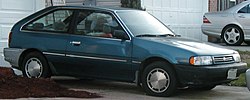| Ford Laser | |
|---|---|
 | |
| Overview | |
| Manufacturer | Ford |
| Also called | Ford Meteor (Australia & South Africa) Ford Liata/ Ford Aztec/ Ford Activa/ Ford Tierra (Taiwan) Ford Lynx (Philippines/Malaysia) |
| Production | 1981–2005 |
| Assembly | Taiwan: Taoyuan City (Ford Lio Ho, CKD) [1] Malaysia: Shah Alam, Selangor [2] Indonesia: Jakarta (IRMC) Vietnam: Hai Duong [3] Thailand: Rayong (AAT) [4] Australia: Flemington [5] Japan: Hofu (Mazda) [5] New Zealand: Wiri [5] Philippines: Santa Rosa, Laguna [6] Venezuela: Valencia, Colombia: Bogotá South Africa: Pretoria Zimbabwe: Willowvale [7] |
| Body and chassis | |
| Class | Subcompact car (1981–1994) Compact car (1994–2005) |
| Layout | |
| Related | Ford Capri Ford Escort (Gen 2 & Gen 3 only) Mazda Familia/323 Mercury Capri Mercury Tracer |
| Chronology | |
| Predecessor | Ford Escort |
| Successor | Ford Focus Ford Escort (China & Taiwan) |
The Ford Laser is a compact car, originally a subcompact car in the first three generations, which was sold by Ford in Asia, Oceania, and parts of South America and Africa. It has generally been available as a sedan or hatchback, although convertible, wagon and pick-up versions have also been available in different markets. The sedan, and briefly station wagon, versions were badged Ford Laser and Meteor in Australia between 1982 and 1987. The Ford Meteor name was also used in South Africa.
Contents
- First generation (KA/KB; 1981)
- Laser (KA/KB)
- Meteor (GA/GB)
- Second generation (BF/KC/KE; 1985)
- Japan
- Australia and New Zealand
- Asia
- North America
- South Africa
- Engine specifications
- Third generation (KF/KH; 1989)
- Australia
- New Zealand
- Taiwan
- Other markets
- Fourth generation (KJ/KL/KM; 1994)
- Japan 2
- Australia 2
- New Zealand 2
- Taiwan 2
- Latin America
- Fifth generation (KN/KQ; 1999)
- Ford Tierra
- Ford Lynx
- References
The Ford Laser was a restyled version of the Familia/323 models produced by Mazda in Japan from 1980 onwards. Ford had acquired a 25% stake in Mazda in 1979.
Platform and assembly-line sharing with the locally produced Mazda Familia in Japan allowed the Laser in that market to be offered with a plethora of engine, paint and trim configurations not available anywhere else in the world. This was most notably evident during the 1980s with multiple turbocharged variants, unique bodyshells such as the cabriolet, and full-time 4WD models all available years before their debuts in other markets (and in some cases, never making it offshore at all). Along with the Japanese produced Ford Telstar and Ford Festiva, the Laser was sold at special Autorama dealerships. [8]
In Australia and New Zealand, where Ford was seen as a local brand, the locally assembled Laser outsold its Mazda twin, the 323, especially in Australia, where the 323 was imported. [9] According to research carried out by Ford Australia in 1984, a third of Laser buyers were unaware that the Ford model was based on the Mazda 323. [10]
However, in neighbouring Asian markets, such as Singapore, Malaysia, Indonesia, and Hong Kong, as well as Japan itself, the reverse was the case, although pooling resources with Mazda allowed Ford to maintain a foothold in the region. This was also the case in South America, South Africa, and the Caribbean, where the Laser was also sold, in many cases being locally assembled.




























































